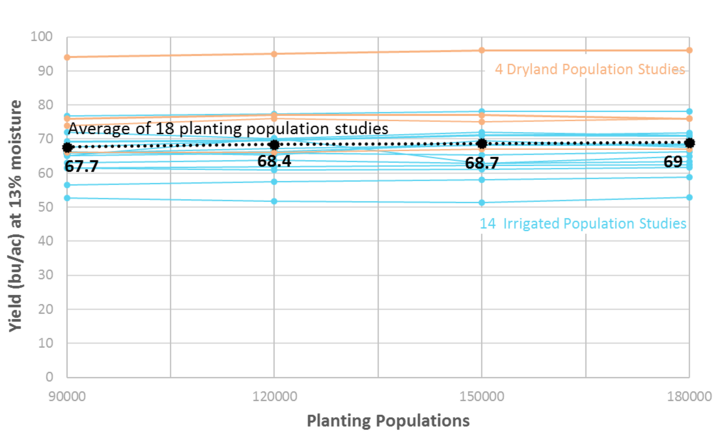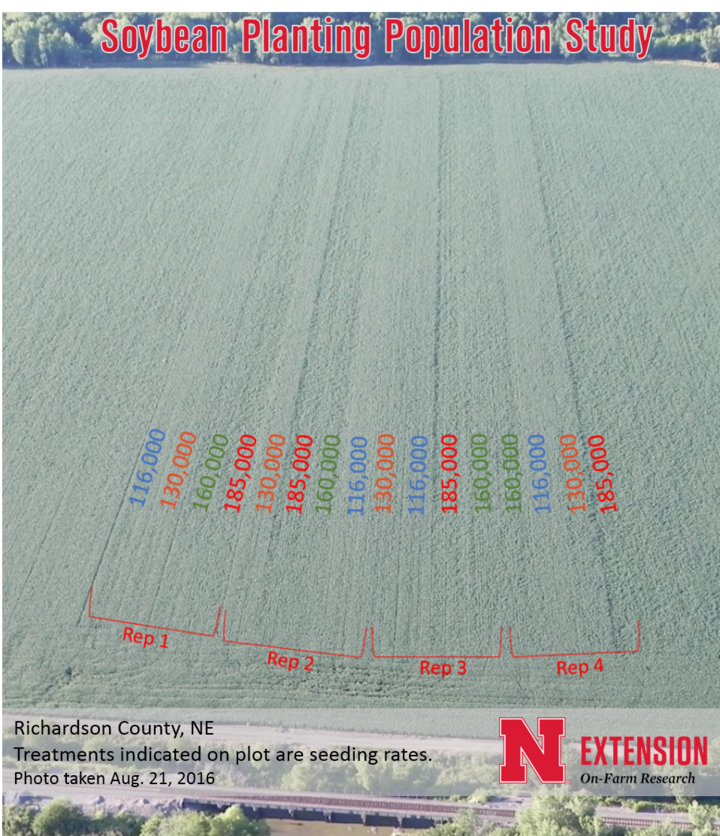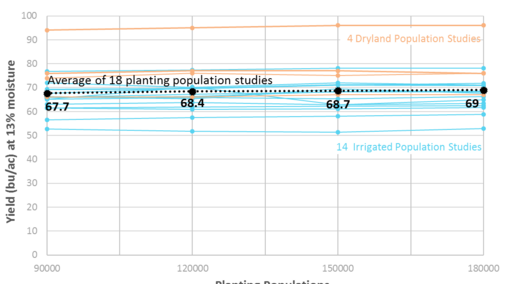It’s a common question for soybean growers, especially as they try to reduce input costs: Can I reduce soybean planting populations and still maintain yield? For 11 years participants in the Nebraska On-Farm Research Network have researched this topic for themselves.

Their findings? Reducing soybean seeding rates from 180,000 or 150,000 seeds/acre to 120,000 seeds/acre doesn’t statistically reduce yields in 30- or 15-inch rows in silty clay loam and silt loam soils in south-central and eastern Nebraska. Results of 18 studies showed for seeding rates of 180K, 150K, and 120K seeds per acre, average yields were 69.0, 68.7, and 68.4 bu/ac, respectively (Figure 1). The early studies within this dataset all had seed germination of at least 90% listed on the seed bag. In all but two situations (seeded at 180,000 and achieving 88% germination), the growers were able to achieve 90% or greater of their planted stand.
This dataset includes:
- The latest soybean varieties as the research was conducted from 2006-2017.
- Erect and bushy type varieties in growth architecture.
- Higher and lower yielding situations.
- Fourteen irrigated fields and four non-irrigated.
- Hail events occurring from cotyledon stage to R2 in some of these fields.
- Crusting in some non-irrigated fields.
- Seed treated in some fields and others without (determined by grower’s planting date).
- In some years, pod and seed count data were also collected; the data showed similar numbers of seeds/acre and ultimately yield per acre.
- Observations of increased plant branching at lower seeding rates and difficulty in telling the seeding rate treatments apart as the season progressed.
Narrow Rows

In a Richardson County field seeding rates of 116K, 130K, 160K, and 185K were planted. There were no statistical yield differences between 185K, 160K, and 130K with yields of 68, 68, and 67 bu/ac, respectively. The 116K seeded rate resulted in a yield of 66 bu/ac. Heavy crusting affected final plant populations, which ranged from 87,600 to 126,000. The highest marginal net return was for the 116K seeding rate.
For two years seeding rates of 90K, 120K, 150, and 180K were compared in 15-inch rows in two Washington County fields. (See related Nebraska Farmer article, Rethinking Optimum Soybean Populations, May 19, 2017.) In 2016 there were non-significant yield differences of 76, 77, 77, and 76 bu/ac respectively and non-significant yield differences of 94, 95, 96, and 96 bu/ac respectively in 2017. In both years, the 90,000 seed/ac population resulted in the highest marginal net return and the grower was able to achieve final plant stands of over 90% of the original seeding rates for all treatments both years.
Recommendation
Our research data for 11 years shows no statistical yield differences in seeding rates from 120,000-180,000 seeds/acre in 15- or 30-inch rows in silty clay loam or clay loam soils. Thus, reducing seeding rates is a way to consider reducing input costs for 2018 without impacting your yield.
- If you plant between 140,000-160,000 seeds/acre, consider dropping your seeding rate to 120,000 and aiming for a final plant stand of 100,000 plants/ac based on our research findings.
- If you plant at 180,000 or more seeds/acre, consider dropping your seeding rate to 140,000 seeds/acre as a step-wise increment.
Here are two examples of savings you could realize from reducing your soybean seeding population:
- If you dropped your seeding rate from 150,000 seeds/acre to 90,000 seeds/acre, you could save $16.46/acre, assuming a yield loss of 1 bu/ac, and a savings of $25.71/ac on seed.
- If you dropped your seeding rate from 150,000 seeds/acre to 120,000 seeds/acre, you could save $10.08/acre, assuming a yield loss of 1 bu/ac, a seed cost of $60 per 140,000 seeds, and a savings of $25.71/ac on seed.
Testing it On Your Farm
Still hesitant? Consider trying this yourself for your location. Consider using either this Two Population Treatment Design or Four Population Treatment Design.
You also can download the Nebraska On-farm Research app, available in Apple and Android, to help you set up your plot design to obtain scientific results. If you have questions or need help setting up your research project, please contact your local Extension educator or anyone involved in our Nebraska On-Farm Research Network.

